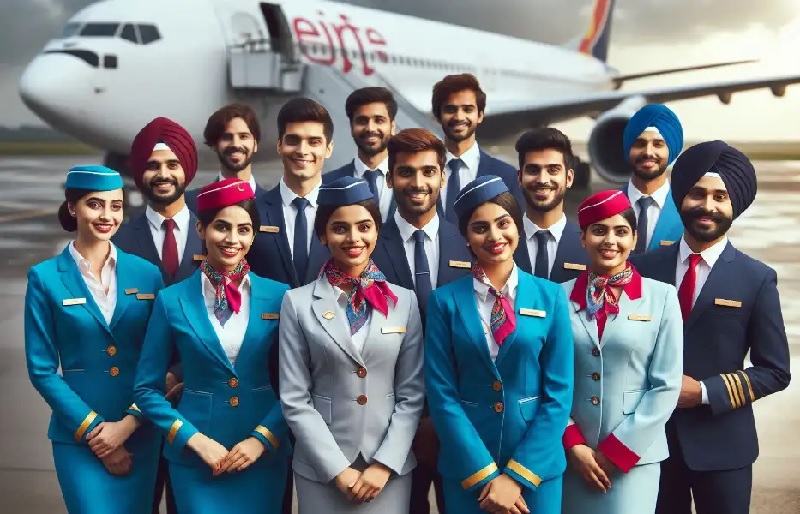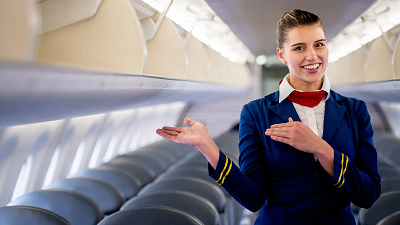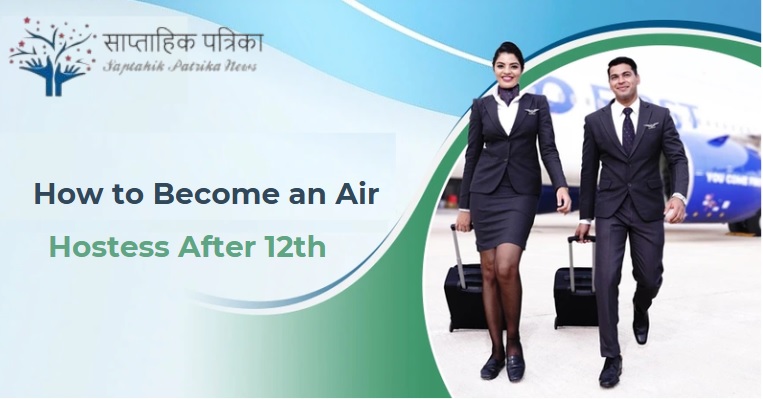Becoming an air hostess, also known as a flight attendant, is a dream career for many young people. The job offers an exciting opportunity to travel the world, interact with diverse people, and enjoy a lifestyle that is both dynamic and rewarding. However, the path to becoming an air hostess is not a straightforward one. It requires meeting specific educational qualifications, undergoing specialized training, and possessing the right skills and attributes.
If you are in your 12th grade and aspiring to become an air hostess,(How to Become an Air Hostess After 12th) this guide will take you through the essential steps, requirements, and tips on how to embark on this career.
Understanding the Role of an Air Hostess
Before diving into the process of becoming an air hostess, it’s essential to understand what the role involves. Air hostesses are responsible for ensuring the safety and comfort of passengers during flights. Their duties include:
- Providing customer service: Assisting passengers with seat arrangements, meal services, and general comfort.
- Ensuring passenger safety: Demonstrating safety protocols, including how to use seatbelts and oxygen masks, and managing emergency situations.
- Maintaining the cabin environment: Ensuring cleanliness, orderliness, and timely service of food and beverages.
- Dealing with emergencies: Handling medical emergencies, evacuations, or any other unforeseen incidents that may arise during the flight.
Given the high level of responsibility, the role demands professionalism, alertness, and the ability to work in a team.
What are the Requirements to Become an Air Hostess?

To become an air hostess, certain eligibility criteria must be met. These criteria usually vary slightly depending on the airline, but there are some general requirements that are standard across most airlines.
Educational Qualifications
The minimum educational qualification required to become an air hostess is typically a 12th-grade pass from a recognized board. However, having a graduation degree can be an added advantage, especially when applying to international airlines.
Age Limit
The age limit for becoming an air hostess varies, but most airlines prefer candidates between the ages of 18 to 27 years. Some airlines may consider candidates up to 30 years of age, especially if they have significant experience or qualifications.
Height and Physical Appearance
Airlines typically have height and weight requirements to ensure that air hostesses are physically capable of performing their duties and fitting in the cabin space. The minimum height for an air hostess is usually around 5 feet 2 inches to 5 feet 6 inches.
In addition to height, a well-groomed and presentable appearance is essential. Clear skin, good posture, and a pleasant smile are factors that airlines look for in their candidates.
Language Skills
Fluency in English is a must, as English is the international language of aviation. Many airlines also prefer candidates who can speak an additional language, particularly in international travel routes. Knowledge of foreign languages such as French, Spanish, Arabic, or Mandarin can be highly beneficial.
Health and Fitness
Candidates must be in good physical health. This is usually determined through a medical examination. The airline will assess whether the candidate has any chronic conditions or health issues that might interfere with their work. Clear vision, good hearing, and an overall healthy physique are essential to meet the demands of the job.
Skills and Personality Traits
In addition to meeting the basic eligibility requirements, certain skills and traits are highly valued in air hostesses:
- Good communication skills: The ability to communicate clearly with passengers and the crew is vital.
- Customer service orientation: Air hostesses must have a friendly, helpful attitude toward passengers.
- Problem-solving skills: They must be able to handle unexpected situations calmly and efficiently.
- Teamwork: Being able to work well with other crew members is a key component of the job.
- Emotional resilience: Managing stress and maintaining a calm demeanor, especially during emergencies or difficult situations, is essential.
Steps to Become an Air Hostess After 12th
If you’re ready to begin your journey to becoming an air hostess, here is a step-by-step guide to help you navigate the process:
1. Complete Your 12th Grade
The first step is to complete your 12th grade from a recognized school or board. Focus on your studies and ensure that you meet the minimum academic qualifications required by airlines. While a background in Science or Commerce may be helpful, it is not mandatory.
Pro Tip: If you plan to pursue a degree alongside air hostess training, consider courses like Hotel Management, Travel and Tourism, or Public Relations. These fields are closely related to the role of an air hostess and will help enhance your skills and employability.
2. Research the Airlines and Training Institutes
Once you’ve completed your 12th grade, the next step is to research the various airlines and training institutes that offer air hostess training programs. There are several well-known institutes in India and abroad that specialize in aviation training.
Some of the top training institutes include:
- Indira Gandhi Institute of Aeronautics (IGIA)
- Frankfinn Institute of Air Hostess Training
- Air Hostess Academy (AHA)
- The Jet Airways Training Academy
- Tata Institute of Social Sciences (TISS)
Choose an accredited institute that provides comprehensive training in areas like customer service, safety protocols, emergency procedures, grooming, and communication.
3. Enroll in an Air Hostess Training Program
Enroll in a professional air hostess training program offered by a reputed institution. These programs typically last between 6 months to 1 year and cover a wide range of subjects. The curriculum includes:
- Cabin Crew Training: Covers everything from safety protocols, emergency procedures, to customer service.
- Personality Development: Helps build your grooming, confidence, and social skills.
- English Language Skills: Focuses on improving communication and language proficiency.
- Medical Training: Teaches basic first-aid, CPR, and handling medical emergencies.
- Cultural Sensitivity: Prepares you to interact with passengers from diverse cultural backgrounds.
4. Acquire Additional Skills
Alongside the formal training program, you should also focus on acquiring additional skills that will improve your chances of securing a job. These include:
- Learning foreign languages: If you know multiple languages, it can give you an edge, especially for international flights.
- Customer service experience: Working in customer-facing roles, such as retail or hospitality, can help you build the necessary skills to interact with passengers effectively.
- Physical fitness: Staying fit and active is essential for air hostesses. Regular exercise can help improve your stamina and overall health.
5. Apply for Jobs with Airlines
After completing your training, it’s time to apply for air hostess positions with airlines. Start by checking the career section of the airline’s official website or job portals. Many airlines conduct walk-in interviews, while others may have scheduled recruitment drives.
6. Prepare for the Interview
Airline interviews for air hostess positions are competitive, and the selection process can be rigorous. Here are some tips to help you prepare for the interview:
- Dress professionally: Choose formal attire that is clean, neat, and appropriate.
- Prepare your resume: Highlight your qualifications, skills, and any relevant experience.
- Be confident: Practice speaking clearly and confidently, maintaining good posture.
- Know about the airline: Research the airline, its fleet, destinations, and values.
- Be ready for group discussions or role-play exercises: Airlines may assess how you handle group discussions, problem-solving situations, and other scenarios.
7. Complete the Airline’s Selection Process
Once you’ve passed the interview and screening, you may be required to undergo a medical checkup and a training session conducted by the airline. This training typically focuses on the airline’s specific policies, cabin crew procedures, and internal protocols.
Once you successfully complete the selection process, you will be hired as an air hostess and assigned to flights as per the airline’s requirements.
Career Growth and Opportunities

As an air hostess, there are ample opportunities for career growth. After gaining some experience, you can be promoted to senior flight attendant or cabin crew supervisor. Additionally, you may also explore roles like:
- Ground Staff: Handling passengers at the airport.
- Flight Purser: Leading the cabin crew on flights.
- Training Instructor: Teaching new recruits the skills and knowledge required to become an air hostess.
With experience, you can even transition to roles in aviation management or public relations.
Final Thoughts of this article
Becoming an air hostess is an exciting and rewarding career choice, especially for those with a passion for travel and customer service. By following the right steps, including completing your 12th grade, enrolling in a reputable training program, and developing the necessary skills, you can successfully enter this glamorous profession.
Remember, the journey to becoming an air hostess requires hard work, dedication, and patience. But with the right mindset and preparation, you can make your dream of flying high a reality.
1. What is the Role of an Air Hostess?
An air hostess, also known as a flight attendant, has a crucial role in maintaining the safety and comfort of passengers during flights. Their responsibilities include:
- Safety briefings: Ensuring passengers understand safety procedures such as seatbelt usage, emergency exits, and oxygen masks.
- Passenger assistance: Helping with boarding, seating arrangements, serving meals, and addressing passenger queries and needs.
- Crisis management: Handling medical emergencies, ensuring calmness during turbulence, and coordinating in case of accidents or emergencies.
- Cleaning the cabin: Maintaining cleanliness, hygiene, and organization in the aircraft.
An air hostess must handle all these tasks while remaining calm, polite, and professional.
2. Types of Air Hostess Jobs
There are various types of roles that an air hostess can take up, depending on the airline and career trajectory. The primary categories include:
- Domestic Flight Attendant: Works on flights that stay within a particular country. The role usually involves shorter shifts and less extensive travel.
- International Flight Attendant: Handles flights that travel to other countries, requiring more time away from home and handling long-haul flights.
- Cabin Crew Trainer: After gaining experience, you can transition to a role where you train new air hostesses. Trainers are responsible for teaching new recruits about safety protocols, customer service, and other skills.
- Senior Flight Attendant (Purser): A senior role where the air hostess supervises the cabin crew, ensures the smooth operation of the flight, and is in charge of passenger safety and service.
- Corporate/Executive Cabin Crew: Some high-end airlines employ specific crews who serve business or first-class passengers with more personalized service. This role often involves handling VIP clients.
3. Skills Required to Become an Air Hostess
To succeed as an air hostess, certain skills are imperative, including:
- Interpersonal Skills: Interacting with passengers from diverse backgrounds requires excellent communication and interpersonal skills. You must be approachable, patient, and courteous.
- Problem-solving Skills: In case of emergencies or passenger complaints, air hostesses must think on their feet and solve problems quickly and efficiently.
- Attention to Detail: Whether ensuring passengers are safely seated or preparing meals, attention to detail is essential for every task.
- Physical Endurance: The job involves long hours, irregular shifts, and the physical demand of standing and walking for extended periods. Keeping in good physical shape is essential.
- Emotional Intelligence: Handling stress and remaining calm in difficult situations—whether it’s a medical emergency or passenger disruptions—is a vital trait.
- Teamwork: The air hostess works as part of a team, so being cooperative and capable of working with colleagues in harmony is key to providing excellent service.
4. Top Air Hostess Training Institutes in India
While you can pursue a career as an air hostess directly after the 12th, enrolling in a certified air hostess training program is highly recommended to gain industry-specific knowledge and skills. Here are some of the top training institutes for aspiring air hostesses in India:
- Frankfinn Institute of Air Hostess Training: One of the most renowned institutes in India, Frankfinn offers comprehensive courses in aviation, hospitality, and customer service. They have placements with leading airlines.
- Indira Gandhi Institute of Aeronautics (IGIA): Offering diploma and degree programs in aviation, IGIA is one of the best for training students in both air hostess duties and aviation management.
- Air Hostess Academy (AHA): AHA provides both short-term and long-term air hostess training programs with a strong focus on practical skills and real-time exposure.
- TMI Academy: Located in several cities, TMI Academy offers programs that train candidates in areas like personality development, safety protocols, and communication skills.
- Capt. Sahil Khurana Aviation Academy: This academy provides specialized training for aspirants interested in becoming cabin crew members with top airlines.
Each institute offers courses that include modules like grooming, safety measures, first-aid, and more. These programs often include internships and placement opportunities with airlines, giving students hands-on experience.
5. Training Modules
A typical air hostess training program covers a broad spectrum of subjects to prepare candidates for the dynamic role:
- Safety Procedures and Emergency Protocols: Air hostesses learn what to do in case of fire, medical emergencies, evacuations, or turbulent conditions.
- Cabin Crew Etiquette: This module covers communication skills, maintaining proper body language, and delivering excellent customer service.
- In-flight Services: The course teaches how to serve food and beverages, manage in-flight entertainment, and ensure a comfortable experience for passengers.
- Health and Fitness: Since physical health is a priority for air hostesses, training often includes physical fitness routines, first-aid procedures, and CPR.
- Cultural Sensitivity and Customer Care: Air hostesses are trained to handle passengers from diverse cultures with sensitivity and respect. This part of the training also covers conflict resolution and managing unruly passengers.
The training period typically lasts between 6 months to 1 year and culminates in a certification. This certificate adds value to your resume, boosting your chances of getting hired by top airlines.
6. Opportunities for Career Advancement
After working as an air hostess for several years, you can climb the career ladder in multiple ways:
- Senior Cabin Crew: After gaining experience, you can be promoted to a senior cabin crew role or a purser position. As a senior flight attendant, you would be in charge of managing the cabin crew, handling customer complaints, and ensuring everything runs smoothly.
- Cabin Crew Supervisor: A step up from the senior flight attendant position, where you supervise a team of flight attendants and ensure the safety and quality of services on board.
- Flight Attendant Manager: With significant experience, you may become part of the airline’s management team, responsible for overseeing the entire flight crew, staff training, and ensuring adherence to safety protocols.
- Corporate Aviation: Air hostesses can transition into working with corporate jets or VIP clients, offering a more personalized and high-end service.
7. Pay and Benefits
The salary of an air hostess varies depending on factors such as the airline, experience, location, and whether you’re flying domestically or internationally. However, the pay scale generally ranges from:
- Starting Salary: Fresh graduates can earn between ₹30,000 to ₹50,000 per month in domestic airlines.
- Experienced Crew: After gaining experience, the salary can rise to ₹60,000 to ₹80,000 per month.
- International Airlines: International airlines tend to offer higher pay, with starting salaries of approximately ₹70,000 per month, and experienced flight attendants can earn upwards of ₹1,00,000 per month.
Additionally, air hostesses often receive other perks, such as:
- Free or discounted travel: Most airlines provide employees with discounted flight tickets, along with free or reduced fares for family and friends.
- Accommodation allowances: For international flights, airlines often provide free accommodation or allowances for hotel stays during layovers.
- Medical benefits: Health insurance coverage and wellness benefits.
- Retirement benefits: Pension plans and other retirement schemes may be available for long-term employees.
Air hostess roles also often include bonuses, commission-based incentives, and performance-based rewards.
Summary
Becoming an air hostess after completing your 12th grade involves meeting basic qualifications, undergoing professional training, and acquiring the necessary skills. With determination and the right preparation, you can successfully embark on this exciting career and enjoy the world of aviation.
FAQ Section
- What are the minimum qualifications to become an air hostess after the 12th?
- The minimum qualification is completing your 12th grade from a recognized board. Some airlines may also require you to be a graduate for higher positions.
- Is a specific age required to become an air hostess?
- Most airlines prefer candidates between 18 to 27 years of age. However, age requirements may vary depending on the airline.
- Do I need to speak multiple languages to become an air hostess?
- Fluency in English is essential, and knowing an additional foreign language can be an advantage, especially for international flights.
- Can I become an air hostess without prior training?
- While it is possible, it’s recommended to undergo a formal air hostess training program that includes safety protocols, customer service skills, and emergency procedures.
- Is the air hostess career only for women?
- No, the air hostess profession is open to both men and women. The role is commonly referred to as “cabin crew” to be gender-neutral.
- What are the height and weight requirements for air hostesses?
- Airlines typically require a minimum height of 5 feet 2 inches and maintain a weight-to-height ratio for optimal physical fitness.
- Can I work as an air hostess internationally?
- Yes, after receiving appropriate training and meeting the language and fitness requirements, you can apply to international airlines and work worldwide.
Disclaimer: This article provides general information about becoming an air hostess. Career requirements may vary based on the airline and country, and the steps outlined are intended for guidance purposes only. Always check with specific airlines or training institutes for their official criteria and procedures.
Good luck on your journey to becoming an air hostess!

